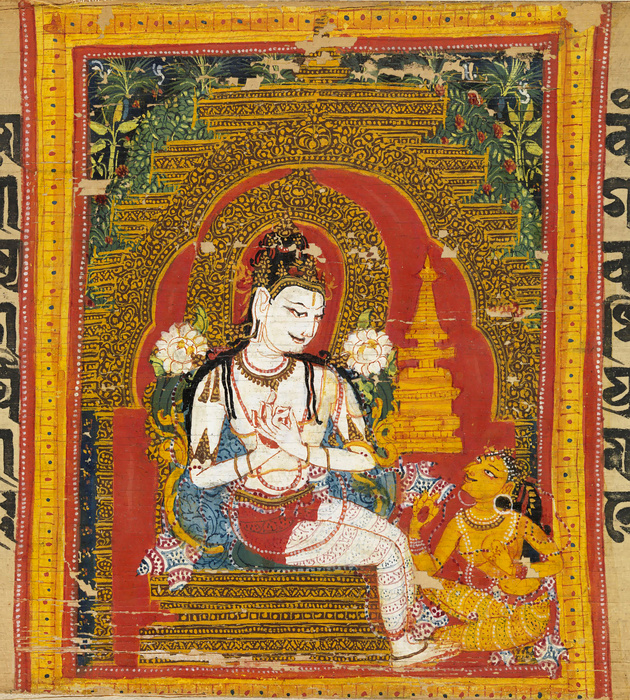|
Tathagatagarbha
Buddha-nature refers to several related Mahayana Buddhist terms, including '' tathata'' ("suchness") but most notably ''tathāgatagarbha'' and ''buddhadhātu''. ''Tathāgatagarbha'' means "the womb" or "embryo" (''garbha'') of the "thus-gone" (''tathāgata''), or "containing a ''tathāgata''", while ''buddhadhātu'' literally means "Buddha-realm" or "Buddha-substrate". Buddha-nature has a wide range of (sometimes conflicting) meanings in Indian and later East Asian and Tibetan Buddhist literature. Broadly speaking, the terms refer to the potential for all sentient beings to be a Buddha, since the luminous mind, "the natural and true state of the mind," the pure (''visuddhi'') mind undefiled by kleshas, is inherently present in every sentient being. It will shine forth when it is cleansed of the defilements, c.q. when the nature of mind is recognised for what it is. The ''Mahāyāna Mahāparinirvāṇa Sūtra'' (written 2nd century CE), which was very influential in the C ... [...More Info...] [...Related Items...] OR: [Wikipedia] [Google] [Baidu] |
Tathāgatagarbha Sūtras
The Tathāgatagarbha sūtras are a group of Mahayana sutras that present the concept of the "womb" or "embryo" (''garbha'') of the tathāgata, the buddha. Every sentient being has the possibility to attain Buddhahood because of the ''tathāgatagarbha''. This concept originated in India but was a major influence in the development of East Asian Buddhism, where it was equated with the concept of ''Buddhadhātu'', "buddha-element" or "buddha-nature". The Tathāgatagarbha sūtras include the '' Tathāgatagarbha Sūtra'', ''Śrīmālādevī Siṃhanāda Sūtra'', '' Mahāyāna Mahāparinirvāṇa Sūtra'' and the ''Aṅgulimālīya Sūtra''. Related ideas are in found in the '' Laṅkāvatāra Sūtra'' and '' Avataṃsaka Sūtra''. Another major text, the ''Awakening of Faith'', was originally composed in China, while the ''Mahāyāna Mahāparinirvāṇa Sūtra'' was considerably extended in China . Comparing the tradition of Tathāgatagarbha sūtras to the Yogachara and Madhya ... [...More Info...] [...Related Items...] OR: [Wikipedia] [Google] [Baidu] |
Mahāyāna Mahāparinirvāṇa Sūtra
The ''Mahāyāna Mahāparinirvāṇa Sūtra'' (Sanskrit; , ; Vietnamese: ''Kinh Đại Bát Niết Bàn'') or ''Nirvana Sutra'' is Mahāyāna Buddhist sutra of the Buddha-nature genre. Its precise date of origin is uncertain, but its early form may have developed in or by the second century CE. The original Sanskrit text is not extant except for a small number of fragments, but it survives in Chinese and Tibetan translation. The ''Nirvana sutra'' was translated into Chinese twice from two apparently substantially different source texts, with the 421 CE translation of Dharmakṣema being about four times longer than the 416 translation of Faxian (as well as the later Tibetan version).Jones, C. V. (2020) ''The Buddhist Self: On Tathāgatagarbha and Ātman,'' p. 30. University of Hawaiʻi Press. The two versions also differ in their teachings on Buddha-nature: Dharmakṣema's indicates all sentient beings have the potential to attain Buddhahood, but Faxian's states some will never ... [...More Info...] [...Related Items...] OR: [Wikipedia] [Google] [Baidu] |
Luminous Mind
Luminous mind ( Skt: or , Pali: ; Tib: ; Ch: ; Jpn: ; Kor: ) is a Buddhist term which appears only rarely in the Pali Canon, but is common in the Mahayana sūtras and central to the Buddhist tantras. It is variously translated as "brightly shining mind", or "mind of clear light" while the related term ''luminosity'' (Skt. ; Tib. ; Ch. ; Jpn. ; Kor. ) is also translated as "clear light" or "luminosity" in Tibetan Buddhist contexts or, "purity" in East Asian contexts. The Theravada school identifies the "luminous mind" with the ''bhavanga'', a concept first proposed in the Theravāda Abhidhamma. The later schools of the Mahayana identify it with ''bodhicitta'' and ''tathagatagarbha''. The luminosity of mind is of central importance in the philosophy and practice of the Buddhist tantras, Mahamudra, and Dzogchen. Early Buddhist texts In the Early Buddhist Texts there are various mentions of luminosity or radiance which refer to the development of the mind in meditation. ... [...More Info...] [...Related Items...] OR: [Wikipedia] [Google] [Baidu] |
Mahayana
''Mahāyāna'' (; "Great Vehicle") is a term for a broad group of Buddhist traditions, texts, philosophies, and practices. Mahāyāna Buddhism developed in India (c. 1st century BCE onwards) and is considered one of the three main existing branches of Buddhism (the other being ''Theravāda'' and Vajrayana).Harvey (2013), p. 189. Mahāyāna accepts the main scriptures and teachings of early Buddhism but also recognizes various doctrines and texts that are not accepted by Theravada Buddhism as original. These include the Mahāyāna Sūtras and their emphasis on the ''bodhisattva'' path and ''Prajñāpāramitā''. '' Vajrayāna'' or Mantra traditions are a subset of Mahāyāna, which make use of numerous tantric methods considered to be faster and more powerful at achieving Buddhahood by Vajrayānists. "Mahāyāna" also refers to the path of the bodhisattva striving to become a fully awakened Buddha ('' samyaksaṃbuddha'') for the benefit of all sentient beings, and is thu ... [...More Info...] [...Related Items...] OR: [Wikipedia] [Google] [Baidu] |
Buddhism
Buddhism ( , ), also known as Buddha Dharma and Dharmavinaya (), is an Indian religion or philosophical tradition based on teachings attributed to the Buddha. It originated in northern India as a -movement in the 5th century BCE, and gradually spread throughout much of Asia via the Silk Road. It is the world's fourth-largest religion, with over 520 million followers (Buddhists) who comprise seven percent of the global population. The Buddha taught the Middle Way, a path of spiritual development that avoids both extreme asceticism and hedonism. It aims at liberation from clinging and craving to things which are impermanent (), incapable of satisfying ('), and without a lasting essence (), ending the cycle of death and rebirth (). A summary of this path is expressed in the Noble Eightfold Path, a training of the mind with observance of Buddhist ethics and meditation. Other widely observed practices include: monasticism; "taking refuge" in the Buddha, the , and the ... [...More Info...] [...Related Items...] OR: [Wikipedia] [Google] [Baidu] |
Dharmadhatu
Dharmadhatu (Sanskrit) is the 'dimension', 'realm' or 'sphere' (dhātu) of the Dharma or Absolute Reality. Definition In Mahayana Buddhism, dharmadhātu ( bo, chos kyi dbyings; ) means "realm of phenomena", "realm of truth", and of the noumenon. It is referred to by several analogous terms from Mahayana Buddhist philosophy, such as Tathata (Reality "as-it-is"), emptiness, dependent co-arising and eternal Buddha. It is the "deepest nature, or essence". Dharmadhātu is the purified mind in its natural state, free of obscurations. It is the essence-quality or nature of mind, the fundamental ground of consciousness of the trikaya, which is accessed via the mindstream. When the buddha-nature has been realised, dharmadhātu is also referred to as the Dharmakāya, the ''Body of Dharma Truth''. It is associated with Vairocana. Historical origin Kang-nam Oh traces the origin of dharmadhatu to the Avatamsaka Sutra. It has been further developed by the Hua-yen school: Understanding ... [...More Info...] [...Related Items...] OR: [Wikipedia] [Google] [Baidu] |
Tathāgata
Tathāgata () is a Pali word; Gautama Buddha uses it when referring to himself or other Buddhas in the Pāli Canon. The term is often thought to mean either "one who has thus gone" (''tathā-gata''), "one who has thus come" (''tathā-āgata''), or sometimes "one who has thus not gone" (''tathā-agata''). This is interpreted as signifying that the Tathāgata is beyond all coming and going – beyond all transitory phenomena. There are, however, other interpretations and the precise original meaning of the word is not certain.Chalmers, RobertThe Journal of the Royal Asiatic Society, 1898. pp.103-115/ref> The Buddha is quoted on numerous occasions in the Pali Canon as referring to himself as ''the Tathāgata'' instead of using the pronouns ''me'', ''I'' or ''myself''. This may be meant to emphasize by implication that the teaching is uttered by one who has transcended the human condition, one beyond the otherwise endless cycle of rebirth and death, i.e. beyond dukkha. Etymolog ... [...More Info...] [...Related Items...] OR: [Wikipedia] [Google] [Baidu] |
Gö Lotsawa Zhönnu-pel
gZhon-nu-dpal (1392-1481), also known as 'Gos Lo-tsa-ba (full name: Yid-bzang-rtse gZhon-nu-dpal) was a famous Tibetan historian and scholar, known as the author of the "Blue Annals". Life and achievements He was born in 1392 at lho kha 'phyongs rgyas. He was a student of the fifth Karmapa Lama, Deshin Shekpa (1384-1415), from whom he received the ''bodhisattva precepts'', as well as Tsongkhapa, and was a teacher of the sixth Karmapa, Thongwa Dönden (1416-1453). He was the abbot of the Karmarñing Monastery and the author of the Blue Annals. Works * His most famous work, the "Blue Annals" (Deb-ther sngon-po), was completed in 1478, near the end of his life, and the text was dictated by him to some of his attendants. * Khrul-sel'', written in 1442-1443. * His wrote a commentary on the '' Ratnagotravibhaga'' which extensively explored and contrasted Buddha-nature Buddha-nature refers to several related Mahayana Buddhist terms, including '' tathata'' ("suchness") but most n ... [...More Info...] [...Related Items...] OR: [Wikipedia] [Google] [Baidu] |
Rangtong-Shentong
''Rangtong'' and ''shentong'' are two distinctive views on emptiness ( sunyata) and the two truths doctrine within Tibetan Buddhism. ''Rangtong'' (; "empty of self-nature") is a philosophical term in Tibetan Buddhism that is used to distinguish the majority Madhyamaka teaching on the meaning of śūnyatā or "emptiness", namely that all phenomena are empty of an enduring and/or unchanging essence or "self," and that this emptiness is not an absolute reality, but a mere nominal characterisation of phenomena. It is related to the '' prasangika'' approach, which argues that no syllogistic forms of reasoning should be used to debate the notion of inherent existence, but only arguments which show the logical implications and absurdity of positions based upon inherent existence. This position is the mainstream Gelugpa interpretation of Madhyamaka, one of the main Mahayana schools, which dominates Vajrayana Buddhism. ''Shentong'' (, also transliterated ''zhäntong'' or ''zhento ... [...More Info...] [...Related Items...] OR: [Wikipedia] [Google] [Baidu] |
Dōgen
Dōgen Zenji (道元禅師; 26 January 1200 – 22 September 1253), also known as Dōgen Kigen (道元希玄), Eihei Dōgen (永平道元), Kōso Jōyō Daishi (高祖承陽大師), or Busshō Dentō Kokushi (仏性伝東国師), was a Japanese Buddhist priest, writer, poet, philosopher, and founder of the Sōtō school of Zen in Japan. Originally ordained as a monk in the Tendai School in Kyoto, he was ultimately dissatisfied with its teaching and traveled to China to seek out what he believed to be a more authentic Buddhism. He remained there for four years, finally training under Tiantong Rujing, an eminent teacher of the Caodong lineage of Chinese Chan. Upon his return to Japan, he began promoting the practice of zazen (sitting meditation) through literary works such as '' Fukanzazengi'' and '' Bendōwa''. He eventually broke relations completely with the powerful Tendai School, and, after several years of likely friction between himself and the establishmen ... [...More Info...] [...Related Items...] OR: [Wikipedia] [Google] [Baidu] |
Alaya-vijnana
The Eight Consciousnesses (Skt. ''aṣṭa vijñānakāyāḥ'') is a classification developed in the tradition of the Yogācāra school of Mahayana Buddhism. They enumerate the five sense consciousnesses, supplemented by the mental consciousness (''manovijñāna''), the defiled mental consciousness (''kliṣṭamanovijñāna''), and finally the fundamental store-house consciousness (''ālāyavijñāna''), which is the basis of the other seven.Waldron, William S. The Buddhist Unconscious: The Alaya-vijñana in the context of Indian Buddhist Thought. Routledge Critical Studies in Buddhism, 2003, page 97 This eighth consciousness is said to store the impressions ('' vāsanāḥ'') of previous experiences, which form the seeds ('' bīja'') of future karma in this life and in the next after rebirth. Eightfold network of primary consciousnesses All surviving schools of Buddhist thought accept – "in common" – the existence of the first six primary consci ... [...More Info...] [...Related Items...] OR: [Wikipedia] [Google] [Baidu] |




